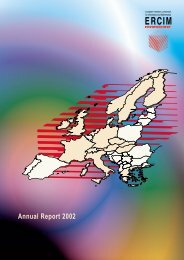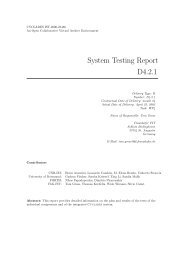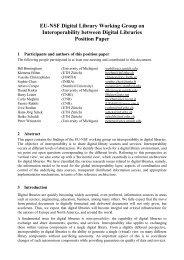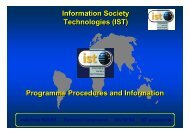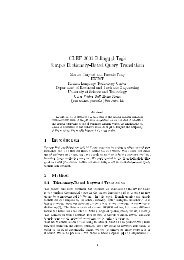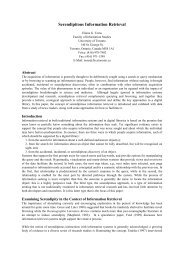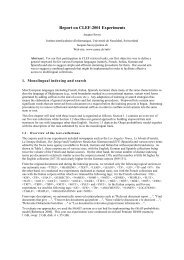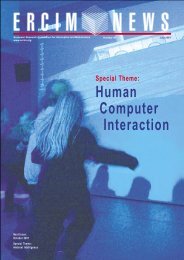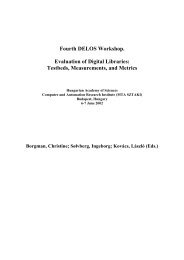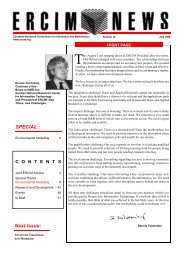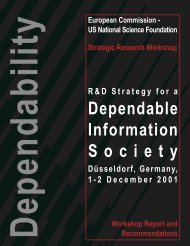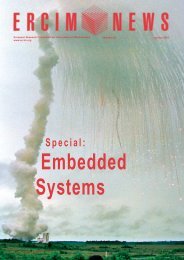Towards a Platform for Widespread Embedded Intelligence - ERCIM
Towards a Platform for Widespread Embedded Intelligence - ERCIM
Towards a Platform for Widespread Embedded Intelligence - ERCIM
Create successful ePaper yourself
Turn your PDF publications into a flip-book with our unique Google optimized e-Paper software.
Triggered Ethernet) can be a basis <strong>for</strong><br />
DECOS-based systems. On top of these<br />
core services, DECOS provides a set of<br />
architectural (or high-level) services:<br />
• virtual networks (VN) and gateways<br />
• an encapsulated execution environment<br />
(EEE)<br />
• diagnostics.<br />
To minimize the dependency of application<br />
programming on a certain DECOS<br />
implementation, a <strong>Plat<strong>for</strong>m</strong> Interface<br />
layer (PIL) provides a techology<br />
invariant interface of the high level services<br />
<strong>for</strong> application tasks.<br />
DECOS Tool-Chain<br />
A constituent element of such an<br />
enabling technology is a tool-chain, currently<br />
being developed by DECOS,<br />
which encompasses all embedded software<br />
design and development aspects,<br />
including configuration and testing. As<br />
illustrated in the figure, the DECOS toolchain<br />
essentially consists of two vertical<br />
'lanes': on the left side, the integrated<br />
system configuration is determined and<br />
middleware is generated, and on the<br />
right side the application functionality is<br />
developed. A third lane, containing tools<br />
<strong>for</strong> testing and verifying the various<br />
(intermediate) results, is not shown.<br />
The specification starts with the<br />
<strong>Plat<strong>for</strong>m</strong> Independent Models (PIMs) of<br />
the application sub-systems, defining<br />
their requirements with respect to communication<br />
(among the application<br />
tasks), per<strong>for</strong>mance, and dependability.<br />
PIMs serve two purposes: firstly,<br />
together with the specification of the<br />
target cluster hardware and resources,<br />
the Cluster Resource Description<br />
(CRD), they are used to derive the<br />
<strong>Plat<strong>for</strong>m</strong> Specific Model (PSM), which<br />
contains allocation (of tasks to nodes)<br />
and other in<strong>for</strong>mation relevant <strong>for</strong> the<br />
successive steps. From PSM, configuration<br />
files and schedules <strong>for</strong> both task<br />
execution and message transmission are<br />
generated, as well as middleware like the<br />
PIL.<br />
Secondly, PIMs are used to guide the<br />
development of jobs (ie application<br />
tasks), by modelling their behaviour with<br />
SCADE (a tool set of Esterel<br />
Technologies). If feasible, predefined<br />
Simulink models or modules written in<br />
conventional languages like C or Ada<br />
can be imported. After application code<br />
is generated from these models, the<br />
results of both activities are integrated to<br />
achieve the target executables, which<br />
can then be downloaded to the application<br />
cluster.<br />
The purpose of the CRD (Cluster<br />
Resource Description) is to capture the<br />
characteristics of the plat<strong>for</strong>m relevant<br />
<strong>for</strong> the software-hardware integration.<br />
This includes computational resources<br />
(CPU, memory), communication<br />
resources and dependability properties.<br />
A graphical domain-specific modeling<br />
environment is developed, based on<br />
GME (Generic Modeling Environment).<br />
The targeted modeling domain is<br />
described <strong>for</strong>mally via the HSM<br />
SPECIAL THEME: <strong>Embedded</strong> <strong>Intelligence</strong><br />
DECOS tool-chain basic steps. Boxes denote activities, and disk symbols denote data.<br />
Grey elements address specification, yellow address design, green ones implementation,<br />
and the blue elements installation.<br />
(Hardware Specification Model), a meta<br />
model which facilitates the validation<br />
and reuse of resource models.<br />
Be<strong>for</strong>e generating the PSM, it is possible<br />
to add in<strong>for</strong>mation manually to the PIM<br />
(PIM marking), <strong>for</strong> example in<strong>for</strong>mation<br />
on specific middleware requirements.<br />
Jobs are assigned to nodes taking into<br />
account functional and non-functional<br />
constraints. In the first phase of assignment,<br />
constraints are dealt with one by<br />
one. Since allocation is an NP-hard<br />
problem, in a second phase a multi-variable<br />
optimisation approach is proposed.<br />
Scheduling is the next step, where a tool<br />
suite (TTplan, TTbuild) of TTTech (a<br />
DECOS partner developing time-triggered<br />
systems) has been adapted to<br />
<strong>ERCIM</strong> News No. 67, October 2006<br />
23



